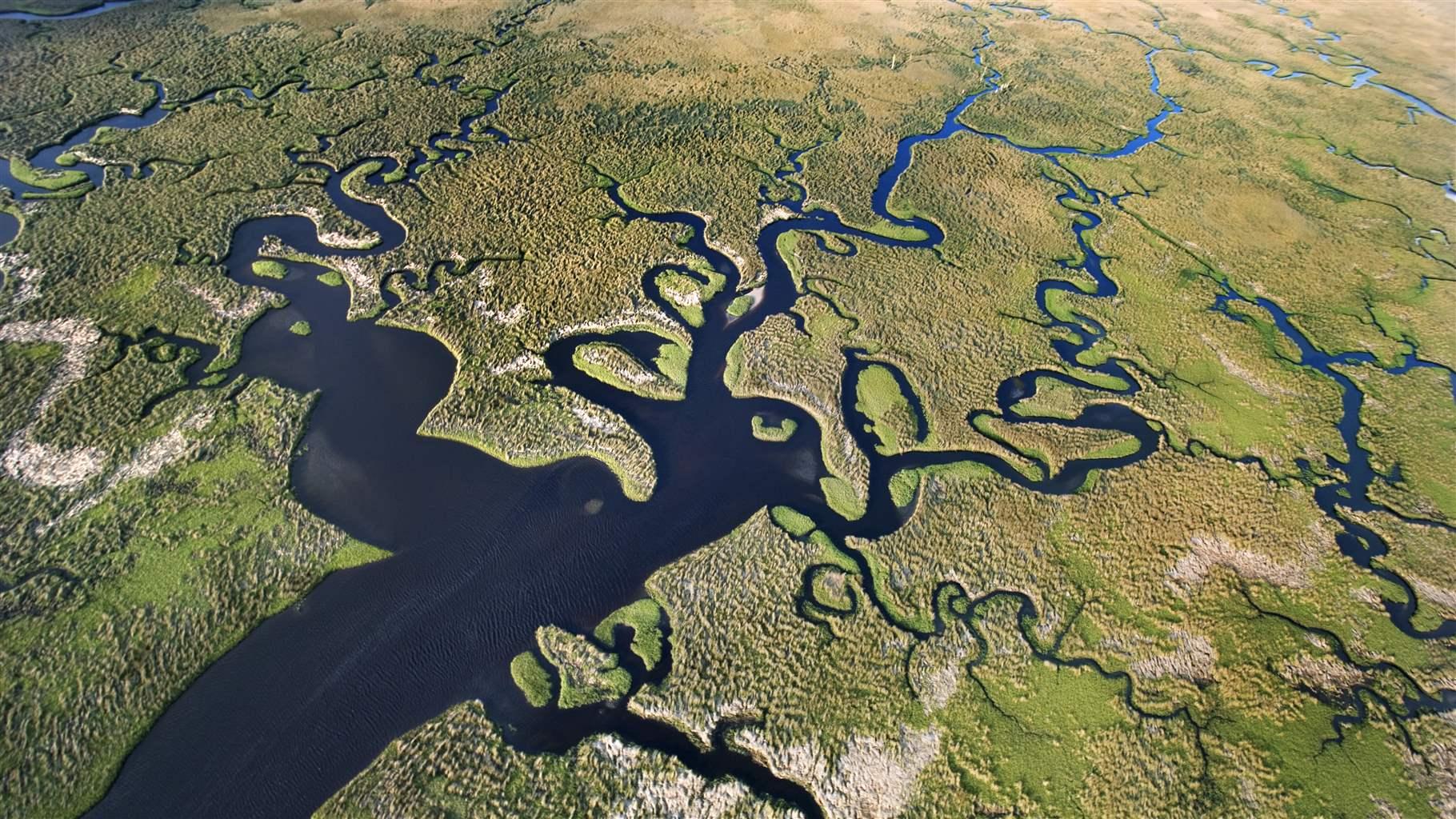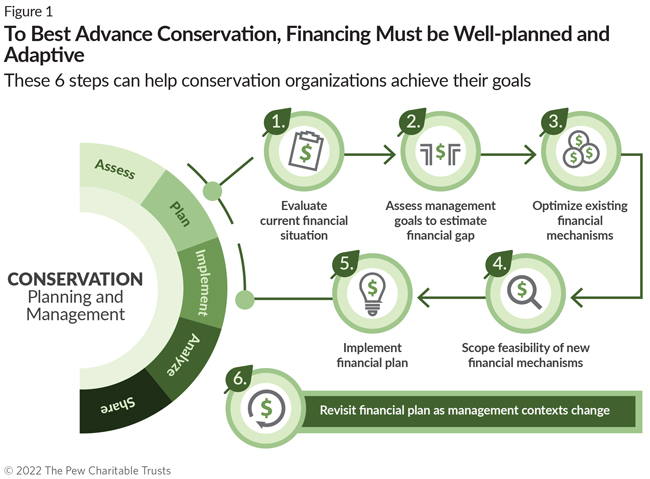To Achieve Lasting Conservation Gains, Organizations Can Take Holistic Approach to Funding
Tightly linking financing and planning from the outset can help groups achieve goals

Note: This article was updated on Aug. 16, 2022, to include a link to a newly published research study.
With climate change and other human-driven threats to both people and nature growing at an accelerated pace, governments, businesses, the philanthropic community, and others are moving swiftly to scale up conservation efforts. The scale of action needed to avoid serious consequences identified by the United Nations’ Intergovernmental Panel on Climate Change and Intergovernmental Science-Policy Platform on Biodiversity and Ecosystem Services, as well as in other research, now stands in contrast with the often-limited budgets for conservation that must stretch across an ever-expanding list of priorities. The United Nations Environment Programme recently estimated there to be a $4.1 trillion gap between the resources necessary to address climate change, protect global biodiversity, and halt land degradation, and the current level of investment. Within this context, conservation organizations are working on how to use existing funds most effectively while also securing more funding to scale impact.
These efforts are part of the larger field of conservation finance, which encompasses more than just attracting funding for protecting the natural world.
A growing body of literature has identified the need for a more holistic approach to conservation finance that encompasses the full life cycle of financial planning, including:
- Examining existing funding.
- Examining financial needs and/or gaps.
- Identifying opportunities to improve or optimize existing funding.
- Identifying new opportunities for sustainable financing.
Achieving this will require deeper integration of financial planning with conservation planning and adaptive management. Failure to do so could leave otherwise thoughtful conservation projects with insufficient funding or result in oversized budgets for activities that are no longer necessary or valuable.
Pew engagement on conservation finance
Pew, which has long been involved in conservation planning and management, is now also focusing on conservation finance. Below are three examples of how conservation finance can support our work and goals.
Chilean Patagonia parks: Although Chile boasts dazzling and diverse natural areas—from soaring peaks and pristine rivers to wildlife-rich coastal and marine regions—public funding for conservation here lags most other countries. Pew recently collaborated with Conservation Strategy Fund, a leading environmental economics and strategy nonprofit, to evaluate funding gaps and determine the scale of opportunity for new funding by the government. Conservation Strategy Fund conducted a national phone survey that found broad public support for increasing national parks funding and willingness among Chilean residents to pay for that increase, such as through donations or environmental fees. Pew’s Chilean Patagonia project is utilizing the results of this research to collaborate with the Chilean government in developing a more holistic process for considering how to finance its national parks.
Offshore and high seas marine protected areas (MPAs): A recent Pew-funded study highlighted the lack of financing strategies tailored to MPAs in offshore and high seas regions, which are governed differently than protected areas on land or near shore. The researchers found that offshore and high seas MPAs are likely to be more reliant on government and philanthropic funds and would benefit from broader coordination on financing across protected areas and among countries, such as by standing up global or regional high seas trust funds.
Coastal wetlands: Research shows that coastal wetlands provide a wide variety of important ecosystem services—such as buffering coasts from storms and sea level rise, recreation, providing food and habitat for wildlife, and sequestering and storing carbon. To date, investments in coastal wetland protection around the world have been insufficient to prevent their ongoing loss and degradation. Pew has been working with the governments of Costa Rica, Seychelles, and Belize to develop appropriate finance mechanisms to support the wetland commitments outlined in their updated Nationally Determined Contributions to The Paris Agreement on climate change. But new action on climate change and wider recognition of the multiple benefits these ecosystems provide have led to an emerging suite of new financing opportunities, such as pay-for-success models. It should be noted that the success and expanded adoption of these new financing mechanisms will depend on improved mapping and quantification of the key ecosystem benefits being financed, such as additional "blue carbon" trapped in the soil, as well as agreed-upon pricing structures such as coastal hazard insurance and global carbon price, for those same benefits.
Challenges to strategic conservation financing
Although there have been numerous advancements made in the field of conservation finance, both in increasing existing funding flows into conservation and in developing innovative financial mechanisms, there are still several key challenges that must be overcome to match the scale of financing to the environmental challenges identified. Firstly, while new opportunities for funding are evaluated, there remains a role for government dollars, namely in investing them in conservation priorities instead of in programs which damage the environment, such as large-scale fossil fuel and agricultural subsidies programs that exist today.
In addition, many innovative financing mechanisms require verification that key ecosystem services—such as blue carbon or coastal resilience—are the direct result of conservation action. There are many opportunities for new partnerships between public and private sector investors, in conjunction with philanthropy and conservation NGOs, to strategically invest in new demonstration projects to pilot new financing mechanisms. Such projects will help to monitor and evaluate the many ecosystem services that could leverage new funding to conservation, while also helping the conservation finance community develop standardized approaches for measurement and verification.
Finally, conservation is inextricably linked to human well-being and community development. Conservation finance can contribute to or help address existing inequalities in conservation—depending on who is providing, and who receives, funding and what projects are scaled—by seeking to achieve both social and ecological outcomes. That approach underpins recent conservation finance models, such as project finance for permanence and conservation impact bonds.
Tackling these key challenges through inclusive, cross-sectoral collaborations will help pave the way towards more holistic approaches in conservation finance, which in turn, will enable conservation outcomes at scale.
Kevin He is a principal associate and Peter Edwards is an officer with The Pew Charitable Trusts’ conservation science program.














